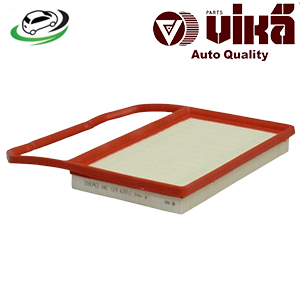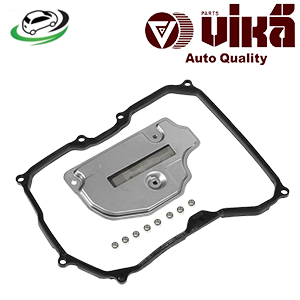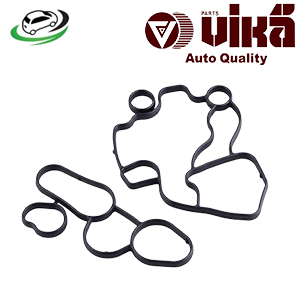-35%
Get Engine Oil Cooler Housing Gasket Audi TT Quattro/ VW Eos GTI 2.0L 06D117070
The engine oil cooler housing gasket is a critical but often overlooked component in a vehicle’s lubrication and cooling system. This gasket ensures a secure and leak-free connection between the oil cooler and the engine block or housing. Here’s an in-depth look at the function, design, types, common issues, maintenance, and replacement of the engine oil cooler housing gasket.
Function of the Engine Oil Cooler Housing Gasket
The primary function of the engine oil cooler housing gasket is to prevent oil and coolant leaks. The engine oil cooler itself is responsible for maintaining optimal oil temperatures by dissipating heat, ensuring the engine operates efficiently and reliably. The gasket:
- Seals Connections: It provides a seal between the oil cooler and the engine block, preventing oil from leaking out and contaminants from entering the oil system.
- Maintains Pressure: It helps maintain the correct oil pressure within the lubrication system.
- Prevents Mixing: In systems where the oil cooler uses the engine’s coolant for heat exchange, the gasket prevents the mixing of oil and coolant, which could lead to significant engine damage.
Design and Materials
The design of an engine oil cooler housing gasket varies depending on the make and model of the vehicle and the type of oil cooler system in use. Common materials used include:
- Rubber: Often used for its flexibility and sealing properties, rubber gaskets can conform to slight imperfections in the mating surfaces.
- Metal: Some gaskets incorporate metal layers or are entirely made of metal for durability and resistance to high temperatures.
- Composite: These gaskets combine rubber, metal, and other materials to balance flexibility, strength, and heat resistance.
Types of Oil Cooler Housing Gaskets
The types of gaskets used in oil cooler housings include:
- O-Ring Gaskets: Circular gaskets that provide a seal between cylindrical surfaces. Commonly used in oil cooler connections.
- Flat Gaskets: Made from rubber, metal, or composite materials, these gaskets are flat and conform to the shape of the oil cooler housing.
- Molded Gaskets: Custom-shaped gaskets designed to fit specific oil cooler housings and connections precisely.
Common Issues with Oil Cooler Housing Gaskets
Over time, oil cooler housing gaskets can deteriorate and fail due to various factors:
- Age and Wear: Gaskets can degrade over time, losing their flexibility and ability to seal effectively.
- Heat and Pressure: Constant exposure to high temperatures and pressure can cause gaskets to become brittle and crack.
- Contamination: Exposure to dirt, debris, and chemical contaminants can compromise the integrity of the gasket material.
- Improper Installation: Incorrect installation can lead to misalignment, causing leaks or gasket damage.
Signs of a Failing Oil Cooler Housing Gasket
Recognizing the signs of a failing oil cooler housing gasket is crucial to prevent further engine damage. Common symptoms include:
- Oil Leaks: Visible oil leaks around the oil cooler housing or under the vehicle.
- Coolant Leaks: If the gasket fails in a system where the oil cooler is integrated with the coolant system, you might see coolant leaks.
- Overheating: A failing gasket can lead to oil or coolant loss, causing the engine to overheat.
- Low Oil Pressure: A compromised gasket can result in oil pressure drops, indicated by dashboard warning lights or gauges.
- Mixed Fluids: In severe cases, oil and coolant may mix, leading to milky oil or coolant.
Maintenance and Prevention
Regular maintenance can help extend the life of the oil cooler housing gasket and prevent failures:
- Routine Inspections: Regularly check for signs of leaks or wear around the oil cooler housing.
- Fluid Levels: Monitor oil and coolant levels and top off as needed. Unexplained drops in levels can indicate gasket issues.
- Oil and Coolant Quality: Ensure the use of high-quality oil and coolant to prevent contamination and chemical degradation of the gasket.
- Proper Installation: When replacing the gasket, follow the manufacturer’s specifications and guidelines to ensure proper installation and alignment.
Replacement of the Oil Cooler Housing Gasket
Replacing the engine oil cooler housing gasket is a task that requires precision and attention to detail. Here’s a general guide on how to replace the gasket:
- Preparation:
- Tools and Materials: Gather the necessary tools, including wrenches, sockets, gasket scraper, and replacement gasket.
- Safety Measures: Ensure the engine is cool before starting the replacement to avoid burns from hot oil or coolant.
- Drain Fluids:
- Oil and Coolant: Drain the engine oil and coolant to prevent spills when removing the oil cooler housing.
- Remove Components:
- Disassemble: Remove any components obstructing access to the oil cooler housing, such as hoses, belts, or engine covers.
- Oil Cooler Housing: Carefully remove the bolts securing the oil cooler housing to the engine block.
- Clean Surfaces:
- Old Gasket Removal: Scrape off the old gasket material from the mating surfaces using a gasket scraper. Ensure the surfaces are clean and smooth.
- Install New Gasket:
- Alignment: Place the new gasket on the oil cooler housing, ensuring it aligns correctly with the bolt holes and sealing surfaces.
- Reassembly: Reattach the oil cooler housing to the engine block, tightening the bolts to the manufacturer’s specified torque settings.
- Refill Fluids:
- Oil and Coolant: Refill the engine oil and coolant, checking for any leaks.
- Testing:
- Start the Engine: Start the engine and let it run for a few minutes, checking for leaks and ensuring proper oil pressure and coolant levels.
Follow us on Facebook for more parts.



